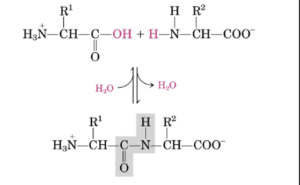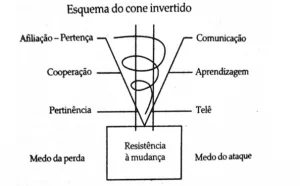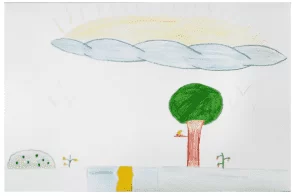PREPRINT
MORAES, Ana Paula Rocha de [1]
MORAES, Ana Paula Rocha de. Archetypal Numerological Alignment – A.N.A.: the mathematical radiography behind the stories. Revista Científica Multidisciplinar Núcleo do Conhecimento. Year. 08, Ed. 01, Vol. 02, pp. 141-151. January 2023. ISSN: 2448-0959, Access link: https://www.nucleodoconhecimento.com.br/psychology/numerological-alignment, DOI: 10.32749/nucleodoconhecimento.com.br/psychology/numerological-alignment
ABSTRACT
Storytelling has accompanied human development since the discovery of fire. It was around the bonfires where knowledge began to be shared. Regardless of language and epochal moment, it was observed that both spoken and written stories follow an archetypal mathematical graduation parameterized in the symbology of Tarot cards, more precisely in the archetypes described in the major arcana and in the archetypal movements, described in the minor arcana. In this way, it was observed that intellectual understanding happens when finding resonance, both in relation to archetypes and archetypal movements[2]. Archetypes precede anything, as they are models that we bring in the unconscious. This means that the understanding of the unfolding of the facts of a story occurs when finding resonance with our unconscious patterns. In this way, based on the archetypes already outlined by Jung, directed at the major arcana, this preprint aims to present the archetypal movements, which, by analysis, proved to be the relevant events whose significance move and give meaning to the stories. It was also observed that these movements happen in an aligned manner, which we call: Archetypal Numerological Alignment – A.N.A.
Keywords: Storytelling, Archetypes, The three-act paradigm, Archetypal movements.
INTRODUCTION
The first analysis of narrative structure that we know of was made by the Greek philosopher Aristotle who, by identifying connections at points that launched the narrative in a specific direction in the pieces of Greek amphitheaters, noticed elements that were repeated and joined them in his book Poetics. As concise as it is essential, Aristotle’s Poetics (384-322 BC) is the first and most important treatise on western literary, scenic and narrative forms (PINHEIRO, 2015).
In the paradigm of this structure, Aristotle divided his work into prologue, episode and exodus: beginning, middle and end.
In this way, it is considered that the writing structure created by Aristotle (384-322 BC) survived the time, gaining new contours, however, still maintaining the basis of the Three Acts Paradigm.
A story is a whole, and the parts that make it up – the action, characters, scenes, sequences, Acts I, II, III, incidents, episodes, events, music, locations, etc. – are what form it. It is a whole, being the structure, what holds the story in place and, the relationship between these parts, what unifies the script, the whole (FIELD, 2014).
Already, a paradigm is a model, example or conceptual scheme. As Aristotle defined, the three units of dramatic action are: time, space and action. According to screenwriter Syd Field (2014), Act I or Presentation is a unit of dramatic action; Act II or Confrontation, is a unit of dramatic action, known as: confrontation. During the second act, the main character faces obstacle after obstacle, which prevent him from achieving his dramatic need; Act III or Resolution is a unit of dramatic action that runs from the end of Act II to the end of the script (FIELD, 2014).
Thus, the Three-Act Paradigm can be defined as a form, not a formula; being what keeps the story cohesive. The backbone, the skeleton and the history determine the structure; the structure does not determine the story (FIELD, 2014).
Through Field’s (2014) opportunities, it is possible to understand that Aristotle’s theory remains active, and is still the basis for many researchers today, as it was for Joseph Campbell (1904/1987) who, by demonstrating the figure of the monomyth in The Hero with a Thousand Faces (1989), also divided it into ‘Three Acts’, in addition to having unveiled, in part, the common veil that exists in all stories regardless of the culture in which they were told.
BEHIND THE THREE-ACT PARADIGM – THE ARCHETYPES
According to Vogler (2015), Campbell’s thought parallels that of the Swiss psychologist Carl G. Jung (1875/1961), who wrote about archetypes: characters or energies that are constantly repeated and appear in the dreams of all people and in myths of all cultures. Jung suggested that these archetypes reflect different aspects of the human mind – that our personalities split into these characters to play out the theater of life.
Vogler (2015), understands that the concept of archetype is an indispensable tool to understand the purpose and function of the characters in a story. Understanding the archetype that a specific character expresses can help determine whether the character is doing their part in the story well. Archetypes are part of the universal language of storytelling, and a mastery of their energy is as essential to the writer as breathing.
THE TAROT AND ITS ARCHETYPES
It can be said that it is illusory to think of archetypes without entering the field of Tarot. Therefore, it is basically approached how the dynamics of these letters works. The Tarot is formed by 78 cards, being: 22 major arcana or archetypes, 40 minor arcana or archetypal movements, and 16 cards representing the court, which, in this study, will be left aside.
Although centuries have passed since the first apparition that has been reported, no one knows exactly the exact origin of the letters or their true authors. However, it seems undeniable to note that they anchored so many important studies, such as those of: Campbell, Jung, Vogler, among others.
Archetypes can be seen as personified symbols of various human qualities. Like the major arcane Tarot cards, they represent aspects of a complete human personality. Thus, stories can be read as metaphors of a general human situation, with characters that embody universal archetypal qualities, understandable for the group and for the individual (VOGLER, 2015).
Jung (2000) seems to have understood part of why stories follow a pattern and, perhaps, because of this, he wrote that “The collective unconscious does not develop individually, but is inherited. It consists of preexisting forms, archetypes, which can only secondarily become conscious, giving a definitive form to the content of consciousness” (JUNG, 2000).
Tarot cards bring strong symbology through images. They are shown to be complementary, as well as their sequence of numbers.
It does not seem like a coincidence that the Major Arcana – The Fool – has Zero as a number stamped on its blade, as it seems possible to conceive that he is the character/protagonist to wear the archetypal clothes during the journey through the major arcana (archetypes ) and move through the 40 minor arcana cards, which are divided into four groups of 10, each ten representing one of the four elements of nature. These are the archetypal movements that symbolize different human “symptoms”. These four groups are subdivided into 2 groups of active elements and two of passive elements:
- Active elements showed to obey the Archetypal Numerological Alignment: Wands: concerns the fire element, which represents the impulses, the impetus of the spirit; Swords: refers to the air element, which represents communication, the verb, intelligence, truth;
- Passive Elements, shown to be able or not to obey the Archetypal Numerological Alignment: Cups: symbolizes the water element, which represents affections, love, emotions; Diamonds: represents the earth element, matter, the body, health, money, material goods. It can also represent family structure.
Therefore, it seems that these archetypal movements would be governed by a greater force, that of the archetypes (the major arcana) or, also called the fifth element, a force from which it is suspected that we could not escape.
The regency of the Major Arcana, in relation to the Minor, would happen obeying the archetypal graduation from 1 to 10. In this way, the order of the regency would be given, in Degrees, as follows: Degree 1: both the Major Arcana I and the Major Arcana XI would govern the Minor Arcana of the same Grade, therefore, Ace of Wands, Ace of Spades, Ace of Cups and Ace of Pentacles; Grade 2: the Major Arcana II and the XII would rule the Minor Arcana 2 of Wands, 2 of Swords, 2 of Cups and 2 of Diamonds; Grade 3: Major Arcana III and XIII would rule Minor Arcana 3 of Wands, 3 of Swords, 3 of Cups and 3 of Diamonds; and so on up to Grade 10: represented by the Major Arcana X and XX, which would rule the 10 of Wands, 10 of Swords, 10 of Cups and 10 of Diamonds.
Figure 1. Tarot Major Arcana/Archetypes
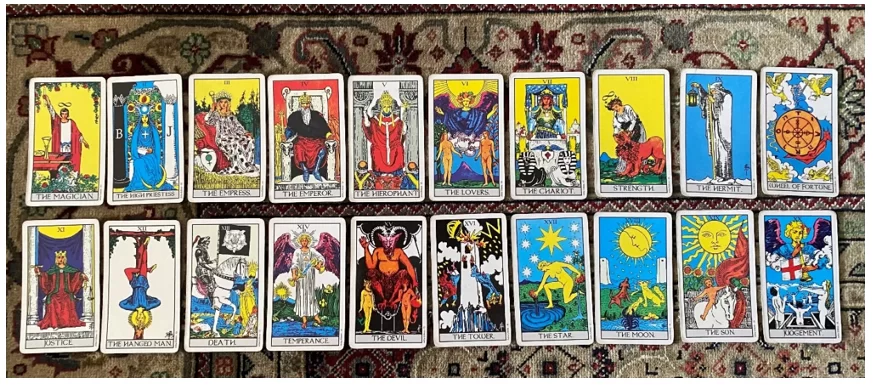
THE JOURNEY OF A.N.A. – ARCHETYPAL NUMEROLOGICAL ALIGNMENT
It was noticed, after analyzing countless stories, that the developments of the events that give meaning to them follow an Archetypal Numerological Alignment, which, perhaps, makes it possible to say that the only possible degree after archetypal graduation 1, would be 2 and then to 3, and, in this way, consecutively until graduation 10. (Note: for better mentalization and simplification of the term Archetypal Numerological Alignment, we decided to call it, just, Journey of A.N.A.).
Figure 2. Major Arcana/Archetypes + Minor Arcana/Archetypal Movements = Archetypal Numerological Alignment – Journey of A.N.A.
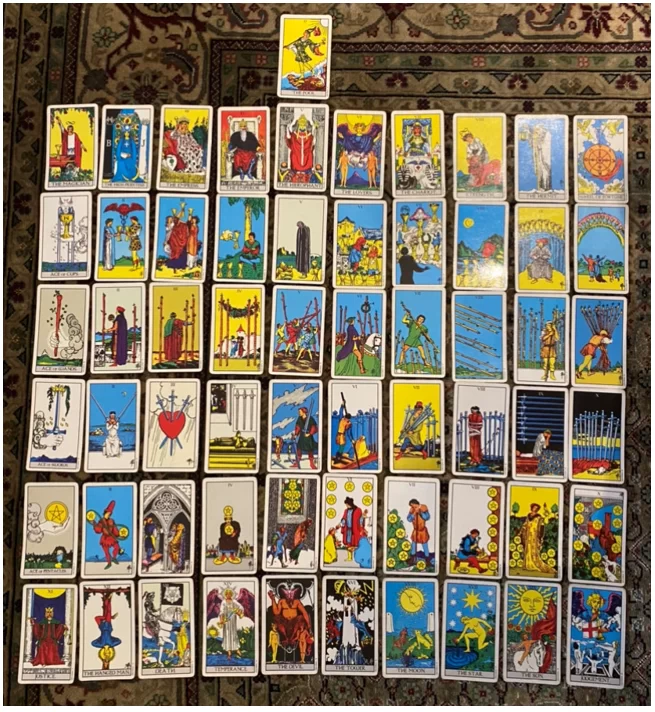
ACTIVE AND PASSIVE ELEMENTS
In possession of the Archetypal Score and in view of the analysis of the films, it was also observed that the elements Cups=Water=Emotion and Diamonds=Earth=Matéria, as previously mentioned, able or not accompany the Journey of A.N.A., as these proved to be unstable. Also said, Passable.
As for the behavior of the elements Sticks=Fire=Spirit and Swords=Air=Mind, these were indeed responsible for boosting the stories, with a higher incidence of the Fire Element. Therefore, it was noted that these are the Archetypal Movements (of these suits or elements), responsible for giving meaning to the feasible developments of a story. Said, Active elements.
The Fire Element, represented by the suit of Wands, concerns the spirit, the drive, what Freud (1856/1939) called libido and Jung (1875/1961) called animus. Already the Air, represented by the suit of Swords, corresponds to the mind, to communication, to the verb. In order for this study to be carried out, it was necessary, in addition to knowing all the Archetypal Movements, to analyze their gradual unfolding in different stories. Since, from this gradual marking of time and archetypal movements, what we call the Archetypal Score, where all the collected data, fruits of this analysis, can be parameterized.
It was noticed that the active elements are completely aligned in a gradual and mathematically increasing way. Therefore, they are primarily responsible for the development of stories, both those told and those experienced by all. In addition to being more marked, as they are about actions or decisions. The passive elements are, depending on the graduation, difficult to perceive.
With these data, the Archetypal Score was parameterized with the symbols below:
= Wands/fire/spirit (active element).
ɞ = Cups/water/emotion (passive element).
- = Diamonds/earth/matter (passive element).
ǂ = Swords/air/mind (active element).
▲ = Major Arcana (1 to 10).
▲° = Major Arcana, 2nd plane (11th to 20th), but still rank 1 to 10.
Table 1. Graduation 1 to 10 – First Experience with the New
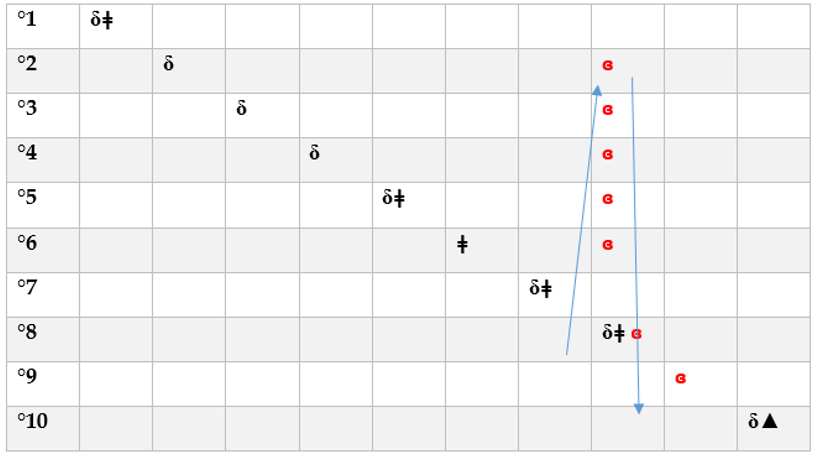
CONCLUSIONS REGARDING THE ALLEGED IMPORTANCE OF A.N.A.’S JOURNEY AND YOUR POSSIBLE CONTRIBUTION
For everything observed so far, it is assumed that the natural construction of stories and the unfolding of facts that make a story intelligible, is due to the ‘obedience’ of a natural archetypal graduation, however, unconscious of the being. Therefore, in possession of this knowledge, it would be risked to say that there is a mathematical radiography behind the stories, whose visualization, through the Archetypal Numerological Alignment, seems to have been possible through the use of the tool named “Archetypal Score”, which seems to have brought to light light the functioning of the mechanisms of the human unconscious.
In this way, it also seems that it would be enough to know the initial archetypal movement of a story so that, when applying the Journey of A.N.A., it would be possible to know all subsequent graduations, even when one does not know the rest of the story to be told. Thinking about cinematographic scripts, I would also venture to say that knowing the initial archetypal movement and the duration of a film, it would be enough to apply the archetypal score divided by the same time and, thus, one could imagine that, from that moment , it would be possible to know all the other movements, both the previous ones and the subsequent ones, until the closure of the cycle proposed by the conflict that gave rise to it. This becomes possible only due to the fact that the rule used in the parameterization of archetypes and archetypal movements seems completely mathematical.
One would also venture to say, based on the use of this new tool, that there is no need to apply the Three Acts Paradigm proposed by Aristotle (384 BC/322 BC), since ‘the beginning, the middle and the end’, would happen, it seems, naturally as long as the protagonist experiences at least two graduations numbered 5 and 6, the first being in the First Half of the Journey, when one seeks to reach the first awakening, and, the second, in the Second Half, when everything would come to light, completely cooling the conflict that motivated it, launching the protagonist of the story that is being told to a new and higher level of consciousness.
In this way, with the help of this new tool, better advice is supposed to be provided regarding the creation, development and understanding of stories. Perhaps allowing more people to take risks in the field of art, such as psychology, philosophy, sociology, anthropology and in all the others in which this tool, in some way, could be applied, since it seems bring us clarity as to the unfolding of our own actions. As it seems, too, that although our actions evolve in order to follow the A.N.A. as far as the active elements are concerned, the way in which we affectively react towards them seems to be individual. Therefore, we risk saying that individuation, which Carl G. Jung (1875/1961) referred to in his extensive book “The Archetypes and the Collective Unconscious”, 1976, seems to concern only, and solely, the affect , therefore, to the way we react to our experiences.
As a result of the brief material anticipated here and the rest that is being carefully prepared, it is hoped that both the Archetypal Numerological Alignment and the Archetypal Score will function as a lighthouse in the sea of story creation, in addition to bringing greater lucidity as to the unfolding behavior and about the journey of the human being.
REFERENCES
FIELD, Syd. Roteiro: Os Fundamentos do Roteiro. Curitiba: Editora Arte e Letra, 2014.
JUNG, Carl Gustav. Os Arquétipos e o inconsciente coletivo. 11ª Ed. São Paulo: Editora Vozes, 2000.
PINHEIRO, Pedro. Aristóteles. Poética. Edição bilíngue. Tradução, Introdução e Notas. São Paulo. Editora 34, 2015.
SMITH, Pamela Colman. Waite, Rider e Smith. Cartas do Tarot de Waite, 1909.
TOP Gun: Maverick. Direção: Joseph Kosinski. Produção: Skydance Media, Jerry Bruckheimer Films, TC Productions e Tencent Pictures. Estados Unidos: Paramount Pictures, 2022.
VOGLER, Christopher. A Jornada do Escritor: estrutura mítica para escritores. Tradução: Petê Rissati. 3a Ed. São Paulo: Editora Aleph, 2015.
APPENDIX-REFERENCE FOOTNOTE
2. Term of Greek origin meaning primitive model. INFOPÉDIA. Archetype. Dicionário Infopédia da Língua Portuguesa, n.d. Available at: https://www.infopedia.pt/dicionarios/lingua-portuguesa/arqu%C3%A9tipo. Accessed on: 17 Jan. 2022.
[1] Graduate student in Positive Psychology. Graduated in Law, OAB/SP: 161.178. ORCID: 0000-0003-3476-2532.
Sent: December, 2022.
Approved: January, 2023.

